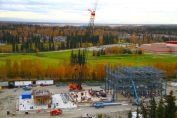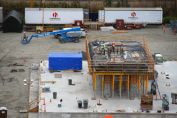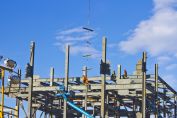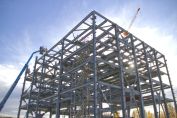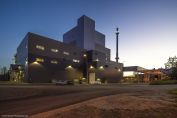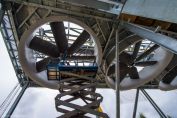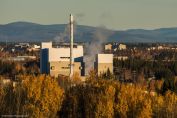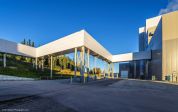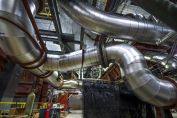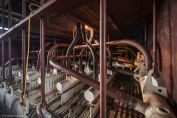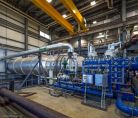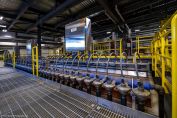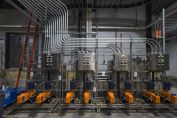Power - Gallery
University of Alaska Fairbanks CHPP

Combined Heating & Power Plant
Haskell Corporation with its Joint Venture partner Davis Constructors of Anchorage, Alaska recently completed construction, startup and performance testing of a new combined heat and power plant at the University of Alaska Fairbanks campus. The new plant replaces a 60-year-old facility that used coal-fired stoker fed boilers.The new facility is centered around a 240,000 pound per hour Circulating Fluidized Bed boiler (CFB) and a Pulse Jet Fabric Filter (PJFF) designed by the Babcock & Wilcox Company of Ohio. The CFB is a significant increase in fuel efficiency over the stoker fed boilers. The CFB combusts the solid fuel while it is suspended in air, allowing the fuel particles to burn on all sides, leading to more complete combustion. This results in 25% less fuel being burned for the same load as the existing plant. The “Circulating” part of the name refers to the design attribute that recirculates unburned fuel particles back into the furnace until they are fully combusted. The resulting carbon conversion of the fuel is nearly 100%. This CFB and PJFF combination produce the lowest particulate emissions of any boiler in the US. The boiler uses limestone injection in the combustion process. The limestone chemically reduces sulfur and nitrogen oxides and attaches itself to particulate matter in the flue gas stream to enhance trapping in the PJFF.
Haskell-Davis was contracted as the University’s Construction Manager at Risk, and in that role provided funding estimates, constructability review, procurement, self-performance of 40% of the work scope, scheduling and management of subcontractors. The boiler was sized to fit the University’s 25-year growth plan. Steam from the facility drives a new 17 MW steam turbine generator manufactured by Shin Nippon Machinery. The extraction turbine provides low and medium pressure steam to heat and cool the campus buildings and produces electricity for the campus demand. The turbine exhaust steam is captured in an air-cooled condenser, which is particularly efficient in the climate of Fairbanks.
The project execution overcame many hurdles. First was the delayed delivery of structural steel for the boiler house. This was overcome through out-of-sequence construction and working in winter conditions using temporary encloses and heat. The schedule was enhanced with the use of off-site construction. The design includes a 440 feet Z-shaped pipe bridge connecting the new facility with the existing. This portion of the work was fabricated in modules at Haskell’s Bellingham yard. The modules contained the structural framing, concrete decks, pipe support racks, 8 piping runs, and cable tray. The modules were set in place in just 6 days, whereas onsite construction would have required 6 weeks. The 22 feet diameter by 43 feet high coal storage silos were pre-assembled in a yard near the site and erected in 3 pieces. The need for a heavy lift crane was minimized by selecting strand jacks to hoist the 51 ton steam drum and 18 ton mud drum in tandem into position. The CHPP is compact, with a ground floor footprint of just 35,000 square feet. But within the 10 stories on this small pad are 3,100 tons of structural steel; 600 tons of concrete reinforcing, 22,000 lineal feet of large bore piping; 16,000 lineal feet of small bore piping; 800,000 lineal feet of wire and cable; 17,000 electrical and instrument terminations; and 3,000 instrument and control devices. Three of the monolithic concrete placements were over 2,000 cy each.
The facility is designated critical infrastructure for the Fairbanks community, as the campus has provided shelter for the community in times of natural disaster. The building is designed with withstand a Magnitude 9 earthquake. It has already been tested by a 5.2 quake and sustained no damage. The control room operators reported not being aware of the temblor.
Excellent communication and cooperation existed between the Owner, Construction Manager, design team, and major suppliers and contributed to the ability to complete within schedule and budget despite challenges. More than 1 million man-hours went into the construction of the facility, which experienced only 2 recordable injuries during the 4-year construction. The UAF CHPP is the first CFB constructed in Alaska and is the largest publicly funded construction project conducted in State history. The plant was selected by Power Magazine as Plant of the Year for 2019.
Click here to view project video.
Click here to view project time lapse construction video.
 Previous Project
Previous Project
